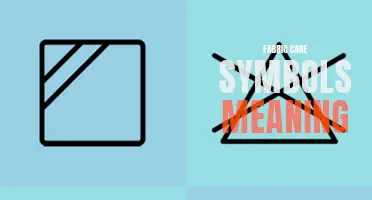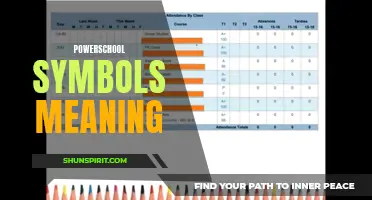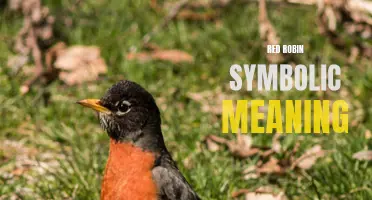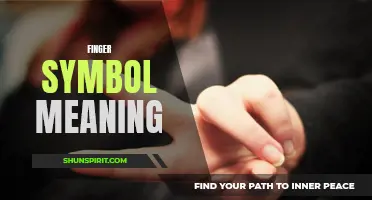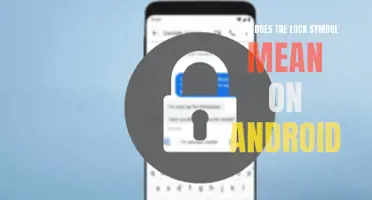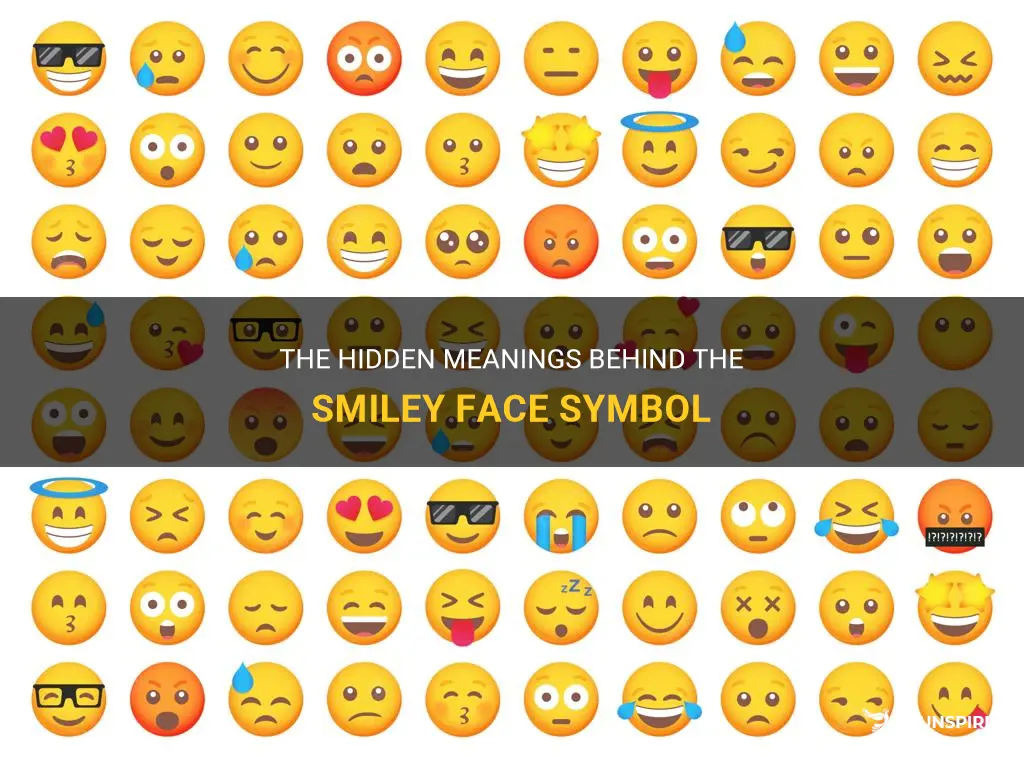
The smiley face symbol is recognized worldwide as a sign of happiness and positivity. The simple yet powerful image of a smiling face with two round eyes and a curved mouth has become a universal language, transcending cultural and language barriers. It is a symbol that brings joy to people's faces and instantly brightens up any communication or expression. However, the deeper meaning behind the smiley face symbol goes beyond its surface appearance, representing the importance of spreading happiness and kindness in our everyday lives. Ultimately, the smiley face symbol serves as a reminder to always wear a smile and share positivity with others, making the world a brighter place.
What You'll Learn
- What is the origin and history of the smiley face symbol?
- How has the meaning of the smiley face symbol evolved over time?
- What are some common interpretations and cultural associations of the smiley face symbol?
- How is the smiley face symbol used in digital communication and social media?
- Are there any variations or alternative symbols that convey similar meanings?

What is the origin and history of the smiley face symbol?
The smiley face symbol is a widely recognized and popular icon that represents happiness and positivity. It is often used in text messages, emails, and various forms of communication to convey a friendly or lighthearted tone. The origin and history of the smiley face symbol date back several decades and have a fascinating story behind its creation and widespread adoption.
The birth of the smiley face symbol can be traced back to the early 1960s when a graphic artist named Harvey Ball was commissioned to create a cheerful image for an insurance company. The company, State Mutual Life Assurance Company, wanted to boost employee morale and asked Ball to design a symbol that would encourage a positive work environment. In just ten minutes, Ball came up with a simple yet effective design – a yellow circle with two dots for eyes and a slightly curved line for a mouth.
The symbol, later known as the smiley face, was an instant success within the company and spread throughout the local community. However, it was not until the 1970s when the smiley face gained widespread recognition and popularity. In 1970, two brothers from Philadelphia named Bernard and Murray Spain saw the potential of the symbol and started using it on various products and merchandise.
The Spains formed a company called "Smiley Associates" and began printing the smiley face symbol on buttons, stickers, and t-shirts. They cleverly marketed the symbol as a way to spread goodwill and happiness. Their efforts quickly paid off, and the smiley face became a cultural phenomenon. It was embraced by various counterculture movements, including the hippie and peace movements, as a symbol of positivity and peace.
The smiley face symbol's popularity skyrocketed in 1972 when a French newspaper launched a "Have a nice day" campaign using the smiley face. The campaign aimed to encourage people to be friendlier and kinder towards one another. The slogan and the smiley face symbol became synonymous with the positive and optimistic mindset that the campaign promoted. The smiley face was featured on billboards, posters, and other promotional materials, further cementing its place in popular culture.
Over the years, the smiley face symbol has continued to evolve and adapt to different mediums. It has become an integral part of digital communication, with various adaptations and variations being created for use in text messages, social media, and other platforms. The symbol has also been integrated into popular culture, appearing in movies, TV shows, and advertisements.
Today, the smiley face symbol continues to be an iconic representation of happiness and positivity. Its simple design and universal message make it a powerful tool for communication and self-expression. Whether it is used to brighten someone's day or signify a lighthearted tone in a conversation, the smiley face symbol has become an enduring symbol of joy and optimism in our modern world.
The Fascinating Symbolism and Meaning of Fox in Different Cultures
You may want to see also

How has the meaning of the smiley face symbol evolved over time?
The smiley face symbol, also known as the emoticon or emoji, has become a prevalent form of communication in today's digital age. What started as a simple way to convey emotions through text has evolved over time, taking on new meanings and uses. Understanding the evolution of the smiley face symbol provides insight into how our communication methods have changed and adapted to new technologies.
The smiley face symbol first gained popularity in the 1980s with the widespread use of personal computers and online communication. It was created by Scott Fahlman, a computer scientist, as a way to distinguish jokes from serious statements in online communication. Fahlman suggested using :-) to indicate a joke and :-( to indicate a serious statement. These simple symbols quickly caught on and became the foundation for what would become a universal language of emotions.
As technology advanced and the internet became more accessible to the general public in the 1990s, the use of smiley faces expanded. People began using them in chat rooms, email communication, and online forums to convey a wide range of emotions beyond just jokes and seriousness. The simple colon and parentheses evolved into a variety of facial expressions, with the addition of symbols such as ;, D, and P to represent different emotions like winking, laughter, and sticking out one's tongue.
With the rise of mobile technology in the 2000s, including smartphones and text messaging, smiley faces underwent another transformation. As space and time became valuable commodities in messaging, the traditional text-based emoticons started to evolve into graphical representations known as emojis. These colorful, cartoon-like images allowed users to convey emotions and ideas more quickly and intuitively.
Emojis quickly gained popularity and became integrated into messaging apps and social media platforms. Today, there are thousands of emojis available, representing a wide range of emotions, objects, and concepts. The smiley face, in particular, still maintains its original meaning of happiness but has expanded to include nuances such as excitement, joy, and contentment.
Furthermore, the smiley face symbol has also taken on cultural significance in certain contexts. For example, in marketing and advertising, smiley faces are often used to convey positivity and customer satisfaction. In other cases, the smiley face has been used as a symbol of counterculture or rebellion, representing a sarcastic or ironic attitude.
In conclusion, the meaning of the smiley face symbol has evolved significantly over time. What started as a simple way to convey emotions in online communication has transformed into a universally recognized language of emotions, with emojis playing a central role in modern digital communication. As technology continues to advance, it will be interesting to see how the meaning of smiley faces and emojis continues to evolve and adapt to new forms of communication.
The Meaning Behind the Vector Symbol: Understanding its Significance
You may want to see also

What are some common interpretations and cultural associations of the smiley face symbol?
The smiley face symbol is one of the most recognizable and widely used symbols in the world. It is a simple representation of a smiling face and is often used in various forms of communication, both online and offline. The symbol has become ingrained in popular culture and has taken on various interpretations and cultural associations over the years.
One of the most common interpretations of the smiley face symbol is that it conveys happiness and positivity. The symbol is often used to express joy, laughter, and amusement. In this sense, the smiley face has become a universal symbol for happiness and is often used to indicate that something is funny or enjoyable. It can be seen in text messages, emails, social media posts, and even in everyday conversations.
Beyond its simple representation of happiness, the smiley face symbol has also been associated with other emotions and expressions. For example, variations of the symbol with different facial expressions, such as a winking face or a sad face, have been created to convey different emotions. These variations allow the symbol to be used in a wider range of contexts and to express a broader range of feelings.
In addition to its emotional connotations, the smiley face symbol has also taken on cultural associations. It is often associated with the hippie movement of the 1960s and 1970s, which embraced peace, love, and happiness as core values. The symbol became a popular emblem for the counterculture movement and was commonly used on posters, clothing, and other merchandise.
The smiley face symbol has also been commercialized and used in branding. It has been used by various companies to symbolize a friendly and approachable image. One of the most notable examples is the use of the symbol by the company Walmart, which features a smiley face in its logo. The smiley face has become closely associated with the brand and is used to convey a positive and welcoming atmosphere in its stores.
In conclusion, the smiley face symbol has become an iconic representation of happiness and positivity. It is widely used in various forms of communication and has taken on different interpretations and cultural associations over the years. From expressing joy and amusement to symbolizing peace and love, the smiley face has become a powerful and universally recognized symbol in popular culture.
The Deep Symbolism Behind Women's Arrow Tattoos Explored
You may want to see also

How is the smiley face symbol used in digital communication and social media?
The smiley face symbol has become a ubiquitous part of digital communication and social media. It is commonly used to express emotions, add emphasis, or convey tone in text-based conversations. The symbol consists of a basic representation of a smiling face using punctuation marks and sometimes additional characters or emojis.
The smiley face symbol is often used to indicate happiness or positivity. It can be used to show appreciation, excitement, or general joy in a conversation. For example, if someone receives good news, they might respond with a smiley face to show their enthusiasm. Similarly, if someone is telling a joke or sharing a funny story, a smiley face can be used to indicate laughter or amusement.
In addition to conveying happiness, the smiley face symbol can also be used to soften the tone of a message or express sarcasm. In written communication, it can be difficult to convey emotions accurately, so the smiley face can help to add context and clarify the intended tone. For example, if someone makes a sarcastic comment, they might add a smiley face to indicate that it is meant in a light-hearted or teasing manner.
The smiley face symbol has evolved in recent years to include a variety of variations and iterations. With the rise of emojis, there are now countless smiley face emojis available, each with its own unique expression and style. These emojis can be used to further enhance the emotional content of a message and provide a more precise representation of the intended emotion.
In social media, the smiley face symbol is commonly used as a form of shorthand or shorthand notation. It can be used to quickly express a reaction or sentiment without the need for a lengthy explanation. Many social media platforms have also incorporated the use of emojis, including smiley faces, as a way to engage users and add visual interest to posts and comments.
Overall, the smiley face symbol is a versatile tool in digital communication and social media. It can be used to express a wide range of emotions, add emphasis, or convey tone. Whether through the use of traditional punctuation or modern emojis, the smiley face symbol has become an integral part of online conversations and a means of connecting emotionally with others.
Unlocking the Mystery: Deciphering the Symbols on Instagram
You may want to see also

Are there any variations or alternative symbols that convey similar meanings?
Symbols play a crucial role in communication and can convey various meanings. However, it is not uncommon to find variations or alternative symbols that convey similar meanings to the original symbol. These variations may arise due to cultural differences, personal preferences, or historical context. Let's explore a few examples of such variations or alternative symbols.
One of the most recognizable symbols is the peace sign, which consists of a circle with three lines inside, forming a downward-pointing triangle. This symbol represents peace and has been widely adopted as a universal symbol. However, there are variations of this symbol that convey similar meanings. For example, the CND symbol, also known as the Campaign for Nuclear Disarmament symbol, consists of a circle with two lines inside, forming an upside-down broken cross. While it has a slightly different design, it still represents peace and opposition to nuclear weapons.
Another symbol that has variations is the heart symbol, which represents love and affection. The common heart symbol consists of two rounded curves meeting at the bottom and a point at the top. However, there are alternative symbols that convey similar meanings. One example is the Ankh symbol, an ancient Egyptian symbol that resembles a cross with a loop at the top. The Ankh symbol represents life, love, and immortality. Although it has a different design, it still conveys the concept of love and life.
The yin and yang symbol is another widely recognized symbol that represents balance and harmony. It consists of a circle divided into two halves, one black and the other white, with a small dot of the opposite color in each half. While this symbol is well-known, there are alternative symbols that convey similar meanings. For instance, the Taijitu symbol, also known as the Tai Chi symbol, represents the same concept of balance and harmony. It features a circle with two curved shapes, one black and one white, interlocking with each other. Although the design is different, it conveys a similar meaning to the yin and yang symbol.
In addition to variations, symbols can also be interpreted differently based on cultural or historical context. For example, the swastika symbol, which was originally an ancient symbol representing good luck and well-being in many cultures, was infamously adopted by the Nazis and now represents hatred and violence. Context can significantly impact the meaning assigned to a symbol, thereby creating alternative interpretations.
In conclusion, symbols often have variations or alternative symbols that convey similar meanings. These variations may arise due to cultural differences, personal preferences, or historical context. Additionally, symbols can be interpreted differently based on the cultural or historical context in which they are used. Understanding these variations and interpretations allows for a more comprehensive understanding of the symbolism and its intended meaning.
Decoding the Dashboard: Understanding the Symbols and Meanings in Your 1999 Toyota Camry
You may want to see also
Frequently asked questions
The smiley face symbol, typically represented by :) or :-), is often used to convey happiness, positivity, or just a friendly tone in written communication. It is a way to express a light-hearted or humorous sentiment and can help to soften the tone of a message.
The smiley face symbol is widely recognized and used in many cultures around the world. While its exact meaning and interpretation may vary slightly, its general association with happiness and positivity transcends language barriers. However, it is important to consider cultural nuances and context when using the symbol to avoid any misunderstanding.
While the smiley face symbol is commonly used in informal or casual communication, its appropriateness in professional settings may vary. In more formal contexts, such as professional emails or business correspondence, it is generally best to use a more professional tone and avoid using smiley faces or other emoticons. However, it ultimately depends on the specific workplace or industry norms.
Yes, there are numerous variations of the smiley face symbol that have evolved over time. Some examples include :), :-), :D, :-D, :), ^_^, ^-^, :), (^_~), and many more. These variations can convey different emotions or intensities of the message, and people often choose the one that best reflects their intended meaning.


